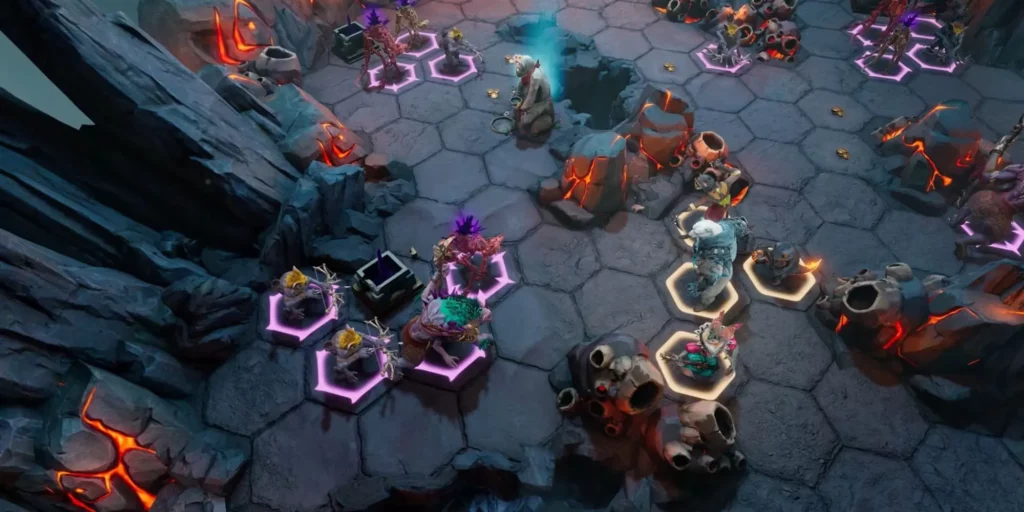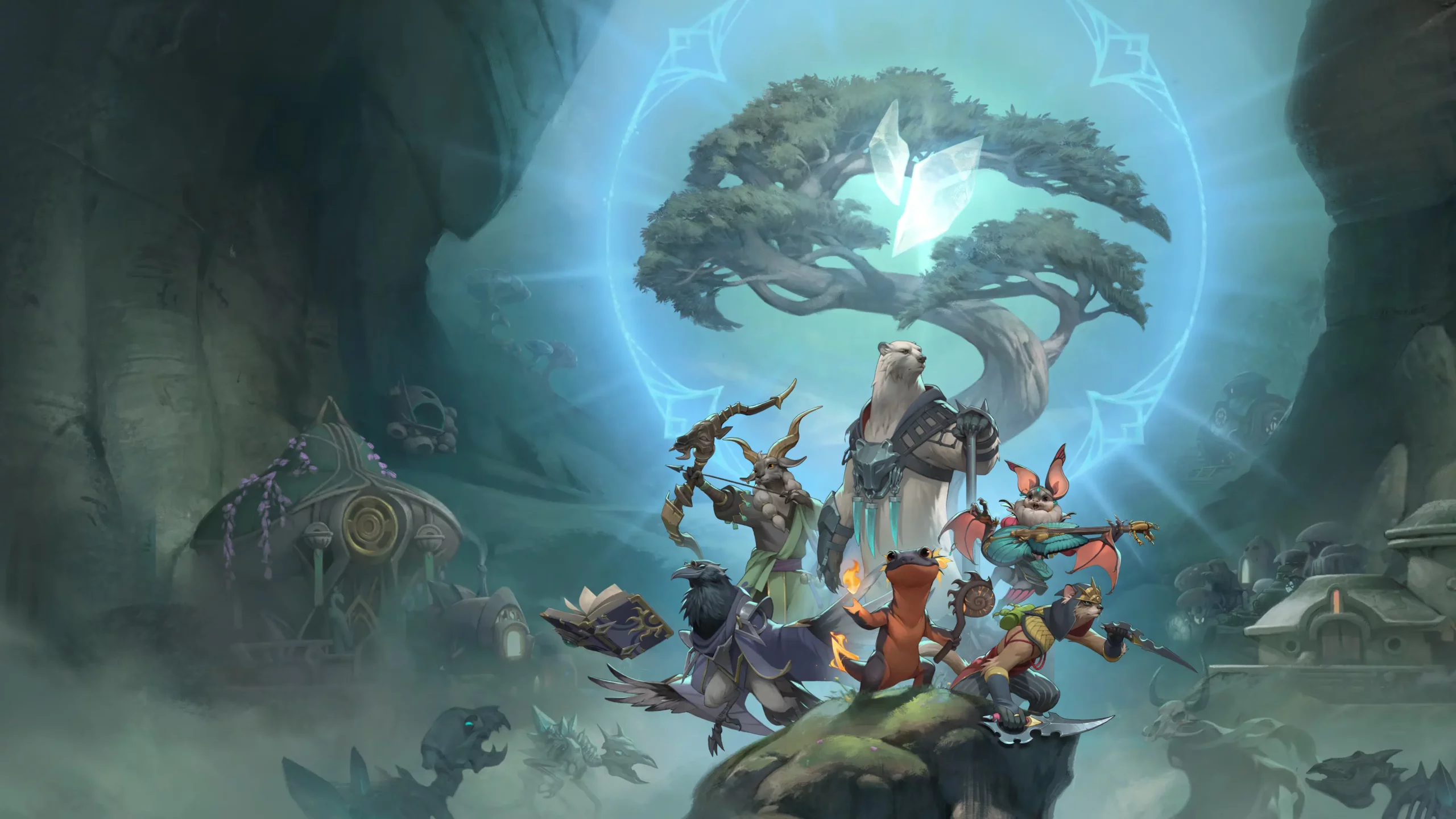Sunderfolk hits its stride when played alongside friends, transforming a casual afternoon into a session of thoughtful tactics and shared laughs. It masterfully blends the core elements of tabletop adventures: collaborative planning and the creation of unique, player-driven moments. While a solitary playthrough might feel underwhelming, the game’s turn-based tactical combat and character abilities are clearly designed to be experienced through coordinated teamwork.
Players take on the roles of one of six engaging anthropomorphic heroes: an arcanist crow, a pyromancer axolotl, a ranger goat, a bard bat, a berserker polar bear, or a rogue weasel. Their journey begins after they prove their worth as protectors of a local tavern. This diverse group unites to defend their home village, Arden, from a growing tide of threats and to combat the spreading corruption of the magical tree that safeguards their world from darkness. The initial premise aligns with familiar fantasy tropes, depicting unlikely heroes answering a call to adventure. For the first few hours, Sunderfolk treads familiar narrative ground.
Engaging NPCs Enhanced by Voice Performance
However, as players interact with the game’s non-player characters, Sunderfolk’s narrative begins to distinguish itself. The entire cast of supporting characters is voiced by Anjali Bhimani, a deliberate choice to emulate the feeling of a tabletop RPG session guided by a Game Master. Bhimani’s impressive vocal range and nuanced delivery bring each character to life with distinct personalities. This skillful voice acting allows players to easily connect with the heroes’ allies and develop strong feelings towards their adversaries. The reviewer noted that their group became deeply invested in the fate of Arden upon meeting Amaia, an endearing one-armed penguin orphan working diligently in the mines, particularly after the introduction of her cruel and deceitful uncle. They collectively resolved to protect Amaia and hoped for her uncle to be revealed as the ultimate villain. This emotional connection, along with their feelings for other characters, was significantly shaped by Bhimani’s captivating performance
Unique Control Scheme and Tactical Battles
Available on both consoles and PCs, Sunderfolk employs an innovative control system utilizing a free companion app on players’ phones or tablets. The game world is displayed on the main screen, while players manage their actions and abilities through the intuitive app interface. The core gameplay revolves around undertaking missions, which primarily involve strategic combat against enemy forces, often with additional objectives such as defense, escort, or exploration. Each hero possesses a unique set of abilities represented as cards within the app. During each turn, players select and play a card, using the touchscreen to direct their movements and target their attacks. While the easiest difficulty offers a more casual experience, higher difficulty levels demand clear communication and collaborative planning to effectively utilize card combinations and overcome the often larger enemy groups. Once a player initiates their turn, others must wait, but players can interrupt their own planning phase if the group decides a different hero should act first, allowing for flexible turn order. However, once an action is executed, it cannot be undone.
Combat unfolds on a hexagonal grid, emphasizing tactical positioning and movement.

The Strength of Collaborative Play
The emphasis on teamwork is Sunderfolk’s most significant strength, and the game truly shines when played with at least one other person to exchange strategic ideas. For the purpose of this assessment, the initial portion of the game was experienced cooperatively, with the reviewer choosing the arcanist class. This character possessed powerful lightning and gravity attacks, the ability to manipulate enemy and ally positions, and teleportation. However, most of these abilities consumed mana, requiring careful resource management. While the arcanist passively regenerated mana at the start of each turn, the amount was often limited, necessitating strategic decisions about when to conserve mana or use mana-generating cards for future actions. One particularly favored card allowed the arcanist to teleport, generating mana based on the number of adjacent creatures at the destination. The reviewer often coordinated with their friends to have the arcanist move first, teleporting a short distance to remain near the party while generating a significant amount of mana for a powerful follow-up turn.
Each hero feels distinct, allowing every player to contribute uniquely to the team’s success. While each character retains their core identity, their abilities are clearly designed to complement those of their allies. The reviewer’s group also included a pyromancer, capable of delivering devastating area-of-effect attacks; a bard, who could heal, buff, and even charm enemies; and a ranger, who excelled at long-range, high-damage attacks. This team composition favored strategies focused on grouping enemies together for maximum impact, a tactic they developed further as they unlocked new cards. For instance, the reviewer acquired a card that allowed the arcanist to pull multiple nearby enemies into a tight cluster before teleporting away, which synergized perfectly with the pyromancer’s ability to leap to a location and unleash a fiery explosion that intensified with the number of affected enemies.
An unpredictable random effect activates at the end of every creature’s turn, potentially introducing unexpected challenges.
Progression and Strategic Customization
Sunderfolk features a rapid progression system, with each level-up typically rewarding players with a new card. This constant influx of new abilities often led to excited discussions among players as they shared their newfound powers, followed by moments of focused contemplation as they decided which older card to replace to make room for the new one. This, coupled with single-use items found during missions or acquired in town, and upgradable weapons, ensures a consistent sense of momentum and growth. There’s almost always a new strategy to explore or a character build to refine, and playing with friends amplifies this feeling, adding more perspectives to consider.
The Central Hub of Arden
Between missions, the group returns to Arden, which serves as the central hub area. Here, the experience offers a degree of individual exploration. Conversations with Arden’s citizens play out silently on the player’s phone, which somewhat diminishes their impact, underscoring the narrative contribution of Bhimani’s voice acting in the main story. Player choices in these dialogues can influence the tone and direction of the conversations and potentially affect the hero’s relationships with other characters. Players can also visit shops to purchase items, go to the tavern for temporary perk-granting meals, and customize their hero’s appearance (cosmetic) or weapons (gameplay-affecting). While Arden starts as a relatively sparse location, players can contribute resources to build or upgrade structures, unlocking additional options. Sunderfolk limits each player to three conversations per visit to Arden to maintain pacing before allowing the group to vote on the next mission. The inability to experience every mission or interact with every character provides an incentive for replayability.

Accessible Tactical Fun for Groups
Missions are generally concise, often concluding in under thirty minutes, making Sunderfolk an accessible game for both short sessions and longer gatherings. It also serves as a great entry point for friends curious about trying a tabletop RPG without the significant time and financial investment often required. This accessibility likely explains the game’s relatively straightforward narrative; players can jump in and quickly grasp the story if they have any familiarity with high-fantasy settings. While this approachability is appreciated, it comes at the cost of narrative complexity and surprising twists. Sunderfolk occupies a middle ground, appealing as both a cooperative tactical experience and a light story-driven adventure.
Player-Driven Memorable Moments
Many of the most cherished moments in Sunderfolk’s story emerge directly from player interaction. Occasionally, the game randomly tasks a player with naming a building, recalling a rare ingredient’s name for a townsperson, or providing a moniker for a newly encountered enemy. The player’s typed response then becomes part of the game’s lore, appearing in other players’ individual conversations or future missions. While purely cosmetic, this feature fosters a sense of belonging and ownership within Arden and its community. The reviewer and their friends fiercely defended the turret-like insect guard dogs they had named, and they celebrated their reappearance in subsequent missions. The reviewer also fondly recalled a moment when a romanced NPC gifted them an item mentioned in an earlier conversation, a seemingly small detail that created a feeling of being remembered and valued, ultimately providing a surprisingly useful gameplay benefit. The reviewer reflected that in that moment, despite recognizing the setup in hindsight, it still made them feel important.
Experiences like these were amplified when playing Sunderfolk cooperatively, solidifying that this is the intended and most rewarding way to experience the game. While solo play is possible, it diminishes the excitement, much like trying to play a tabletop RPG alone. The distinct playable heroes and their unique card-based abilities are designed for cooperative strategies, and the process of brainstorming and experimenting with new builds alongside friends is as enjoyable as witnessing well-executed plans come to fruition. Sunderfolk excels at emulating the feeling of playing a tactical tabletop game with friends, where the most memorable moments are those created collaboratively, rather than solely following a predetermined narrative.
